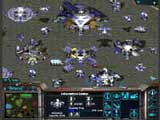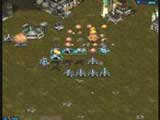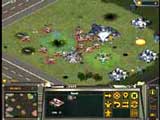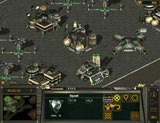 Outlive,
the new release produced by Take 2 Studios in cooperation with
Continuum Entertainment, a game design company from Brazil, claims to
be a breakthrough in the RTS gaming market, combining revolutionary
AI with stunning graphics. Unfortunately, Outlive truly deserves to
its name; it becomes a real question of whether or not the player will
be willing to outlive dated graphics, uninventive and tedious gaming
scenarios, and blatant references to earlier, more successful RTS
releases to finish even the single player missions.
Outlive,
the new release produced by Take 2 Studios in cooperation with
Continuum Entertainment, a game design company from Brazil, claims to
be a breakthrough in the RTS gaming market, combining revolutionary
AI with stunning graphics. Unfortunately, Outlive truly deserves to
its name; it becomes a real question of whether or not the player will
be willing to outlive dated graphics, uninventive and tedious gaming
scenarios, and blatant references to earlier, more successful RTS
releases to finish even the single player missions.
 Outlive
focuses its plot development on environmental concerns in the near
future of Earth. Having depleted all the available mineral and fuel
resources on Earth, plans are being made to try and discover new
supplies on other planets within the Solar System and develop methods
to acquire those resources. The plot focuses on the
development of two alternatives: genetic bio-engineering and robotic advancements. As
both of these projects progress, terrorists strive to bring down the
ruling powers to create anarchy on Earth. These terrorist plots are
aided by deep schisms within the ruling hierarchy, resulting in a
political and military mess that the player is expected to resolve
through the use of brute force and strategy. Much of the game’s plot
is developed through brief cutscenes and mission briefings that try to
tie the actual gameplay into a much broader timeline of events.
Outlive
focuses its plot development on environmental concerns in the near
future of Earth. Having depleted all the available mineral and fuel
resources on Earth, plans are being made to try and discover new
supplies on other planets within the Solar System and develop methods
to acquire those resources. The plot focuses on the
development of two alternatives: genetic bio-engineering and robotic advancements. As
both of these projects progress, terrorists strive to bring down the
ruling powers to create anarchy on Earth. These terrorist plots are
aided by deep schisms within the ruling hierarchy, resulting in a
political and military mess that the player is expected to resolve
through the use of brute force and strategy. Much of the game’s plot
is developed through brief cutscenes and mission briefings that try to
tie the actual gameplay into a much broader timeline of events.
 Many
of the ideas and theories presented in Outlive could be very topical,
especially in the view of the current energy crisis taking place in
the United States, which is also spreading to affect peoples in other
parts of the globe, including Brazil. The plotline, however, is very
simplistic and does little to examine many of the ethical or
philosophical questions that should arise when dealing with either
artificial intelligence or scientific exploration of genetic
materials. Rather, the game focuses on the simple formula of political
corruption, betrayal, and other shopworn themes that can be
found in hundreds of other games. The progression of the plot is only
demonstrated through slow scenario introductions which combine text
outlines and voice-overs that add nothing to the overall presentation
of the game.
Many
of the ideas and theories presented in Outlive could be very topical,
especially in the view of the current energy crisis taking place in
the United States, which is also spreading to affect peoples in other
parts of the globe, including Brazil. The plotline, however, is very
simplistic and does little to examine many of the ethical or
philosophical questions that should arise when dealing with either
artificial intelligence or scientific exploration of genetic
materials. Rather, the game focuses on the simple formula of political
corruption, betrayal, and other shopworn themes that can be
found in hundreds of other games. The progression of the plot is only
demonstrated through slow scenario introductions which combine text
outlines and voice-overs that add nothing to the overall presentation
of the game.
The game format itself also misses the boat. The control interface mirrors those
found in almost every other RTS games, with the added options of
controling the amounts of resources allocated to unit maintainence and
scientific research. While the idea is interesting, the actual
application of these options merely adds to the tedious scenario
layout, wherein achieving the scenario goals often turns out to be
nothing more than a simple process of obtaining resources, producing a
sufficient number of units, and wiping out all enemy resistance. There
is no real need for any kind of real strategy within the game itself;
the units act in such predictable ways that many of the same gaming
styles that have worked for me in other games lend themselves to this
game as well.
In addition to the predictability of the units
themselves is the sheer number of units. More often than not, I found
myself despairing when the new scenario map opened because I realized
the amount of time that it would take in order to clear out the enemy.
There was no sense of challenge or interest in the game; it became
more and more often just a question of determination: How much time
was I willing to spend in order to clear out the level? There was no
such thing as a developing strategy; I had to resort to the same
tatics on each level; I just tired of the time it took to implement
these strategies. I mean, how many times can I take out a series of
defense towers and enjoy it? There were no differences in the ways the
enemy was deployed, how his/her forces reacted to my presence, or the
requirements of the scenario. This being the case, what enjoyment
could I possibly derive from the game?
 In
essence, from the moment I opened the box, I could tell this was a
game influenced directly by Blizzard’s Starcraft which, in my humble
opinion, has set the standard for subsequent RTS games. Having been
released in 1998, Starcraft still remains as one of the greatest games
of all time, especially in the RTS genre. Much of this comes as a
result of Blizzard taking the time to examine tendencies and trends in
the RTS field and trying to create a game that adapted and altered the
expectations of many of its players. We saw an increased focus on
plot, game play that no longer merely focused on the simple mantra of
harvest, produce, and destroy, and the creation of characters that
actually interested gamers. Unfortunately, Outlive did examine
Strcraft, but did not seem to learn any of these ideas about
innovation; replication seems to be the name of the game here.
However, when this occurs, mediocrity seems to be the best possible
result and Outlive seems to follow the formula to a tee.
In
essence, from the moment I opened the box, I could tell this was a
game influenced directly by Blizzard’s Starcraft which, in my humble
opinion, has set the standard for subsequent RTS games. Having been
released in 1998, Starcraft still remains as one of the greatest games
of all time, especially in the RTS genre. Much of this comes as a
result of Blizzard taking the time to examine tendencies and trends in
the RTS field and trying to create a game that adapted and altered the
expectations of many of its players. We saw an increased focus on
plot, game play that no longer merely focused on the simple mantra of
harvest, produce, and destroy, and the creation of characters that
actually interested gamers. Unfortunately, Outlive did examine
Strcraft, but did not seem to learn any of these ideas about
innovation; replication seems to be the name of the game here.
However, when this occurs, mediocrity seems to be the best possible
result and Outlive seems to follow the formula to a tee.
However, I would not want to place all the blame for
this failure on the shoulders of T2 and Continuum Entertainment. I
think that Outlive stands as a great representation of a larger and
more looming problem taking place in the gaming market in general.
While new and innovative games are being released at this time, the
majority of the games that are being presented to the market are
perfect examples of the axiom: Competence, not excellence. Is Outlive
a competent game? Yes, it does contain enough gaming principles and
follows enough formulas to rate the title of a competent game. Yet, is
there anything in its design that shows that the designers and
programmers were reaching for excellence, for something truly
revolutionary or different? Sadly, the answer is no. Everything within
the game merely reaches for a standard that is easily achievable and
readily obtainable. Thus, Outlive merely adds more thrust to the
movement towards mediocrity. Does this mean that gamers will just play
Outlive because it is thrust upon them? Of course not. With other,
more interesting games on the market, Outlive will just become another
title on a list of available games, another line on a resume, another
box gathering dust in some video game store.
 The
problem lies in the sheer number of games that could truly aim for the
excellent, could be so much more than just retail stock that a game
store has to put on sale in order to move. Excellence merely reflects
the sacrifice, thought, and effort that must take place during the
inception and creation of a game. It is hard to believe that the
writers, programmers, and other personnel taking part in game
development do not want to create games that truly represent their
abilities and skills. Yet too many games are being released that stand
as testament to the fact that these companies are willing to take the
short cuts to gain short term profits rather than taking the more
painstaking and difficult path that leads to radical innovations in
gaming technology. Unfortunately, until more developers are willing to
live by the idea of Excellence, not just Competence, we will be forced
to remain living in a world of Outlives and other should-have-beens
and could-have-beens.
The
problem lies in the sheer number of games that could truly aim for the
excellent, could be so much more than just retail stock that a game
store has to put on sale in order to move. Excellence merely reflects
the sacrifice, thought, and effort that must take place during the
inception and creation of a game. It is hard to believe that the
writers, programmers, and other personnel taking part in game
development do not want to create games that truly represent their
abilities and skills. Yet too many games are being released that stand
as testament to the fact that these companies are willing to take the
short cuts to gain short term profits rather than taking the more
painstaking and difficult path that leads to radical innovations in
gaming technology. Unfortunately, until more developers are willing to
live by the idea of Excellence, not just Competence, we will be forced
to remain living in a world of Outlives and other should-have-beens
and could-have-beens.
